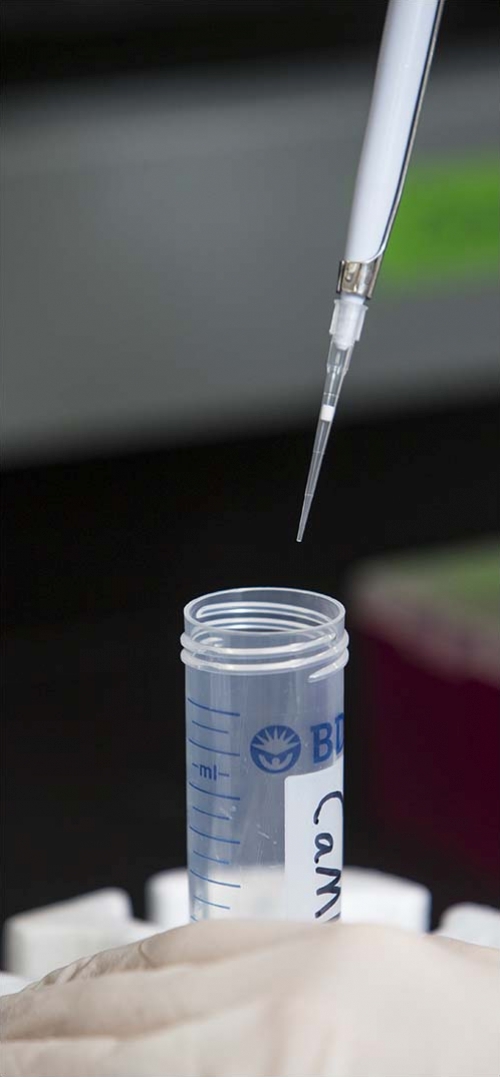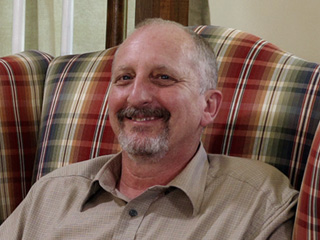Stewards of the Visual Exposition
Eastern Epidemic
Publisher's note: The authors of this post, Kathy Muse and Kathryn Kennedy, are contributors to ECU News Services.

ECU student Erica Bell and Dr. Zac Domire work with a ultrasound device that helps with diabetic foot ulcer research.
"Stick out your tongue," may be the phrase most commonly associated with a doctor's appointment.
But for patients living with diabetes, doctors should also ask that they remove their shoes.
That's because complications from diabetes can include foot ulcers, which increase a patient's risk of infection. Routine ulcer care, treatment of infections, amputations and hospitalizations cost Americans billions of dollars each year, according to the American Diabetes Association.
While ECU Physicians medical providers are emphasizing foot checks in their routine care for diabetics, researchers at East Carolina University are studying the causes of foot ulcers in hopes that their work will lead to preventive treatments.
Dr. Zac Domire, associate professor of kinesiology in the College of Health and Human Performance, has begun researching stiffness in diabetic foot tissue because he believes it is connected to the cause of foot ulcers.
"We are using the latest technology to research an area that has not been studied," Domire said. When someone with a rigid foot takes a single step, their weight is not distributed broadly and the result is elevated pressures in the sole of the foot, Domire said.
"Our hypothesis is that stiffness causes high pressures in areas of impact...which damages the tissue." The imaging technique Domire uses to examine foot tissues is called shear wave elastography. This ultrasound technology uses sound waves to produce vibration in tissue and standard ultrasound procedures to produce images of the resulting waves. Tissue stiffness can be calculated based on how fast the waves travel.
The goal is to develop a computer model of the subject's foot that can be used to design and test different interventions to reduce stiffness and alleviate pressures on the foot.
"We want to make the model subject-specific to match the tissue of the person," Domire said. "That's never been done in a foot model."
Doctoral student Erica Bell is also working on the project. Bell expects to graduate in 2018 with a doctoral degree in bioenergetics and exercise science.
"Increased knowledge of the causes and mechanisms of diabetic foot ulcers can potentially lead to targeting prevention treatments and improve orthotic development for diabetics suffering from plantar foot ulcers," Bell said.
Domire plans to begin recruiting participants for the study in 2016. He is collaborating with Dr. Matthew McCullough at N.C. A&T State University.
— Kathy Muse
A sore toe brought Roanoke Rapids resident Macon Reavis to his doctor's office in 1996 — the year he was diagnosed as a Type 2 diabetic.
An ECU Physicians patient, Reavis knew he was at risk from an early age. Both his parents were diabetic in their later years. Still, he was disappointed at the news.
"I had kept my weight down, ate well, played sports," he recalled recently. "I'd done all the things I could have done. They said because of that, I'd probably delayed it 10 years."
Though Reavis, now 72, is managing his condition well, others aren't so fortunate. Diabetes — a condition involving high levels of sugar (glucose) in the blood — is the seventh leading cause of death among North Carolinians. And Type 2 diabetes, wherein a person's body is unable to use the insulin hormone to absorb glucose, represents more than 90 percent of all diagnosed adult cases in the nation.
Those statistics are among what's driving East Carolina University scientists to seek new therapies for treating the disease — including one initiative aided by a five-year, $1.65 million grant from the National Institutes of Health.
Dr. Carol Witczak, assistant professor of kinesiology in the College of Health and Human Performance and of biochemistry, molecular biology and physiology in the Brody School of Medicine, is spearheading research into how exercise reduces the onset of Type 2 diabetes.
She is focused on a protein called Calmodulin Kinase Kinase, which she previously identified as effective in moving glucose from the blood into both healthy and Type 2 diabetic muscle cells. She demonstrated that this protein functions in much the same way exercise does to build muscle and to stimulate muscle to consume more glucose, leaving less glucose to linger bloodstream.
"Most people with Type 2 diabetes don't realize that exercise can lower their blood glucose levels independent of the other beneficial effects of exercise, such as weight loss or lowering blood pressure," Witczak said.
 Learning how exercise increases glucose absorption into muscle cells is an important first step toward new pharmaceutical treatments for Type 2 diabetes that could yield similar benefits as exercise, according to Witczak. As more research reveals the relationship between Calmodulin Kinase Kinase and exercise, she hopes the results can also be used to develop a test that could gauge an individual's response to the protein, enabling doctors to prescribe personalized exercise programs tailored to individual patients.
Learning how exercise increases glucose absorption into muscle cells is an important first step toward new pharmaceutical treatments for Type 2 diabetes that could yield similar benefits as exercise, according to Witczak. As more research reveals the relationship between Calmodulin Kinase Kinase and exercise, she hopes the results can also be used to develop a test that could gauge an individual's response to the protein, enabling doctors to prescribe personalized exercise programs tailored to individual patients.
Doctoral candidate Jeremie Ferey, who studies bioenergetics and exercise science, is working with Witczak on this project.
"Calmodulin Kinase Kinase is a protein that can modify other proteins and turn them on or off, leading to changes in the ability of muscle to use glucose," he said.
Witczak will continue collecting data in the pre-clinical stage of this research and hopes to begin conversations with pharmaceutical companies about new drug development in the next several years.
The multidisciplinary project is also supported by Dr. Darrell Neufer, director of the East Carolina Diabetes and Obesity Institute; Dr. Jeffrey Brault, assistant professor of kinesiology, physiology, biochemistry and molecular biology; and Dr. Tonya Zeczycki, assistant professor of biochemistry and molecular biology at Brody.
"Understanding the mechanisms controlling glucose uptake and metabolism in muscle is essential to understanding the primary changes in cellular function that leads to diabetes," said Neufer. "The research is critical to devising new and effective strategies for preventing and treating diabetes."
Exercise is key to how Reavis manages his diabetes, said his physician, Dr. Robert Tanenberg, endocrinologist at ECU and medical director for the university's Diabetes Clinical Research Center. Reavis walks two miles daily and plays golf twice a week. That activity is supplemented by insulin therapy and medication and also a restricted diet. He eats what he wants, he explained, "I just don't eat all of it."
Reavis said he and his family come to ECU Physicians for care because of the "special attention" they give to diabetes, which he first observed bringing his daughter in to treat her Type 1 diabetes.
"I'm aware I've got to do things more or differently than perhaps I would have before," he said. But otherwise, Reavis insists, the disease does not run his life.


Research by ECU professor Dr. Carol Witczak, left, with Ph.D. candidate Jeremy Ferey examines the effect of exercise on diabetes. (Photos by Cliff Hollis)
Go Back
Researchers explore innovative treatments for Type 2 diabetes

ECU student Erica Bell and Dr. Zac Domire work with a ultrasound device that helps with diabetic foot ulcer research.
Alleviating diabetic foot ulcers
"Stick out your tongue," may be the phrase most commonly associated with a doctor's appointment.
But for patients living with diabetes, doctors should also ask that they remove their shoes.
That's because complications from diabetes can include foot ulcers, which increase a patient's risk of infection. Routine ulcer care, treatment of infections, amputations and hospitalizations cost Americans billions of dollars each year, according to the American Diabetes Association.
While ECU Physicians medical providers are emphasizing foot checks in their routine care for diabetics, researchers at East Carolina University are studying the causes of foot ulcers in hopes that their work will lead to preventive treatments.
Dr. Zac Domire, associate professor of kinesiology in the College of Health and Human Performance, has begun researching stiffness in diabetic foot tissue because he believes it is connected to the cause of foot ulcers.
"We are using the latest technology to research an area that has not been studied," Domire said. When someone with a rigid foot takes a single step, their weight is not distributed broadly and the result is elevated pressures in the sole of the foot, Domire said.
"Our hypothesis is that stiffness causes high pressures in areas of impact...which damages the tissue." The imaging technique Domire uses to examine foot tissues is called shear wave elastography. This ultrasound technology uses sound waves to produce vibration in tissue and standard ultrasound procedures to produce images of the resulting waves. Tissue stiffness can be calculated based on how fast the waves travel.
The goal is to develop a computer model of the subject's foot that can be used to design and test different interventions to reduce stiffness and alleviate pressures on the foot.
"We want to make the model subject-specific to match the tissue of the person," Domire said. "That's never been done in a foot model."
Doctoral student Erica Bell is also working on the project. Bell expects to graduate in 2018 with a doctoral degree in bioenergetics and exercise science.
"Increased knowledge of the causes and mechanisms of diabetic foot ulcers can potentially lead to targeting prevention treatments and improve orthotic development for diabetics suffering from plantar foot ulcers," Bell said.
Domire plans to begin recruiting participants for the study in 2016. He is collaborating with Dr. Matthew McCullough at N.C. A&T State University.
— Kathy Muse
An ECU Physicians patient, Reavis knew he was at risk from an early age. Both his parents were diabetic in their later years. Still, he was disappointed at the news.
"I had kept my weight down, ate well, played sports," he recalled recently. "I'd done all the things I could have done. They said because of that, I'd probably delayed it 10 years."
Though Reavis, now 72, is managing his condition well, others aren't so fortunate. Diabetes — a condition involving high levels of sugar (glucose) in the blood — is the seventh leading cause of death among North Carolinians. And Type 2 diabetes, wherein a person's body is unable to use the insulin hormone to absorb glucose, represents more than 90 percent of all diagnosed adult cases in the nation.
Those statistics are among what's driving East Carolina University scientists to seek new therapies for treating the disease — including one initiative aided by a five-year, $1.65 million grant from the National Institutes of Health.
Dr. Carol Witczak, assistant professor of kinesiology in the College of Health and Human Performance and of biochemistry, molecular biology and physiology in the Brody School of Medicine, is spearheading research into how exercise reduces the onset of Type 2 diabetes.
She is focused on a protein called Calmodulin Kinase Kinase, which she previously identified as effective in moving glucose from the blood into both healthy and Type 2 diabetic muscle cells. She demonstrated that this protein functions in much the same way exercise does to build muscle and to stimulate muscle to consume more glucose, leaving less glucose to linger bloodstream.
"Most people with Type 2 diabetes don't realize that exercise can lower their blood glucose levels independent of the other beneficial effects of exercise, such as weight loss or lowering blood pressure," Witczak said.
 Learning how exercise increases glucose absorption into muscle cells is an important first step toward new pharmaceutical treatments for Type 2 diabetes that could yield similar benefits as exercise, according to Witczak. As more research reveals the relationship between Calmodulin Kinase Kinase and exercise, she hopes the results can also be used to develop a test that could gauge an individual's response to the protein, enabling doctors to prescribe personalized exercise programs tailored to individual patients.
Learning how exercise increases glucose absorption into muscle cells is an important first step toward new pharmaceutical treatments for Type 2 diabetes that could yield similar benefits as exercise, according to Witczak. As more research reveals the relationship between Calmodulin Kinase Kinase and exercise, she hopes the results can also be used to develop a test that could gauge an individual's response to the protein, enabling doctors to prescribe personalized exercise programs tailored to individual patients.
Doctoral candidate Jeremie Ferey, who studies bioenergetics and exercise science, is working with Witczak on this project.
"Calmodulin Kinase Kinase is a protein that can modify other proteins and turn them on or off, leading to changes in the ability of muscle to use glucose," he said.
Witczak will continue collecting data in the pre-clinical stage of this research and hopes to begin conversations with pharmaceutical companies about new drug development in the next several years.
The multidisciplinary project is also supported by Dr. Darrell Neufer, director of the East Carolina Diabetes and Obesity Institute; Dr. Jeffrey Brault, assistant professor of kinesiology, physiology, biochemistry and molecular biology; and Dr. Tonya Zeczycki, assistant professor of biochemistry and molecular biology at Brody.
"Understanding the mechanisms controlling glucose uptake and metabolism in muscle is essential to understanding the primary changes in cellular function that leads to diabetes," said Neufer. "The research is critical to devising new and effective strategies for preventing and treating diabetes."
Exercise is key to how Reavis manages his diabetes, said his physician, Dr. Robert Tanenberg, endocrinologist at ECU and medical director for the university's Diabetes Clinical Research Center. Reavis walks two miles daily and plays golf twice a week. That activity is supplemented by insulin therapy and medication and also a restricted diet. He eats what he wants, he explained, "I just don't eat all of it."
Reavis said he and his family come to ECU Physicians for care because of the "special attention" they give to diabetes, which he first observed bringing his daughter in to treat her Type 1 diabetes.
"I'm aware I've got to do things more or differently than perhaps I would have before," he said. But otherwise, Reavis insists, the disease does not run his life.


Research by ECU professor Dr. Carol Witczak, left, with Ph.D. candidate Jeremy Ferey examines the effect of exercise on diabetes. (Photos by Cliff Hollis)
| Seeking Input | East Carolina University, School News, The Region, Neighboring Counties | In the Christmas Spirit: Piano Guys, Part V |





















